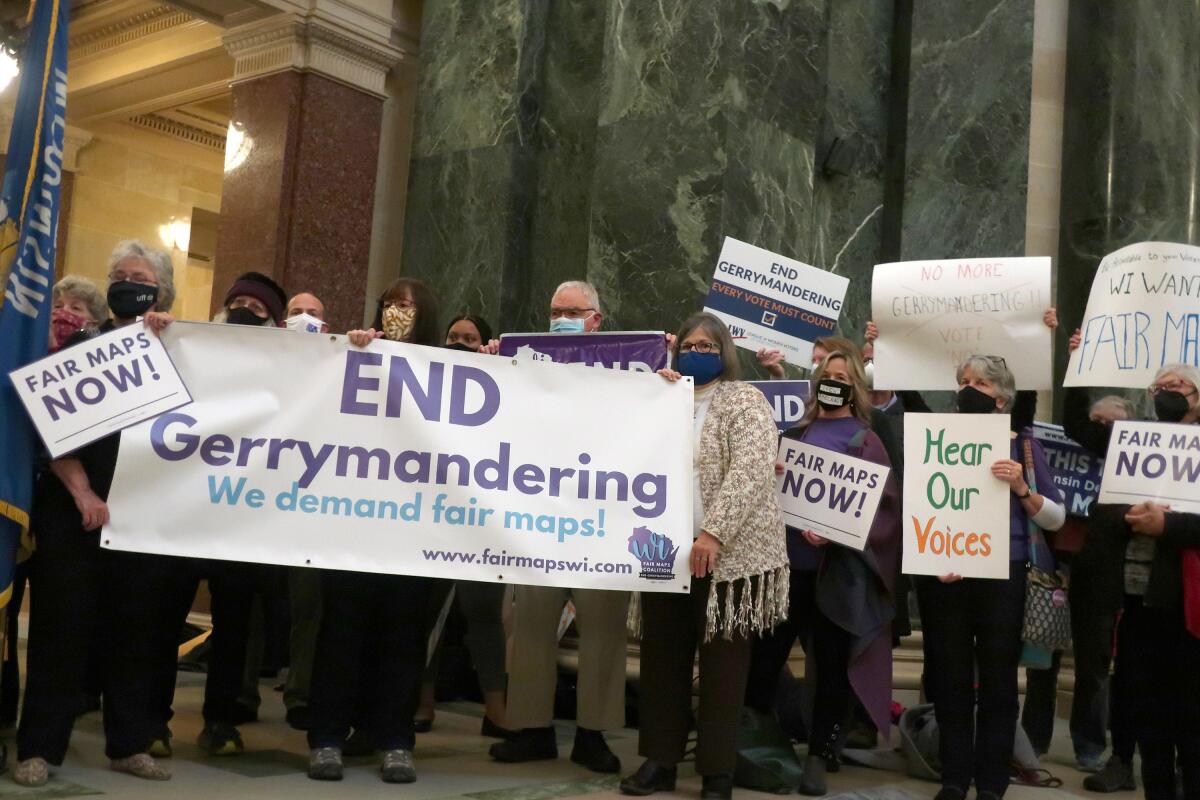Op-Ed: A big reason the South goes red? Gerrymandering and voter suppression

I’ve lived in the South more than half of my life and by now, I’ve heard just about every stereotype about the “Southern voter.” The Southern voter is white, racist, uneducated and Republican. They vote against their own interests and get what they deserve because they’re too ignorant to understand the issues at stake.
In the aftermath of elections, blue-state voters threaten to disown Southern voters and often blame them for every unsatisfactory electoral outcome. These crude jabs fail to grasp the breadth and depth of voter suppression in the South.
Despite widespread grass-roots organizing, with each passing year, Republican leaders succeed in enacting more laws and rules that make it increasingly difficult to vote, and these measures disproportionately affect Black and other minority voters.
To add insult to injury, after the 2020 census, Republican-controlled Southern state legislatures diluted the power of minority voters when they redrew district maps in an even more discriminatory and partisan manner. Thus, not only do Southern voters face serious barriers to voting, but GOP gerrymandered congressional and state legislative districts have reduced the value of their votes.
Calmes: Thanks to gerrymandering, Republicans can continue to behave abominably and win the midterms
Republicans redraw existing districts to make them safer for Republicans and group Democratic-leaning voters into as few districts as possible.
Redistricting following the 2020 census brought about the first new maps since the Supreme Court, in Shelby County vs. Holder, gutted the 1965 Voting Rights Act’s preclearance provision. Southern states with a history of racial gerrymandering no longer needed the approval of the Justice Department to redraw their district lines.
After the census, in the absence of preclearance, lawmakers redrew district lines that either lumped Black and other minority voters into fewer districts or divided them up into multiple white districts — two techniques known as “packing or cracking.” Voters and civil rights organizations have filed lawsuits challenging the legality of these new maps.
One such case involves Alabama. In Merrill vs. Milligan, plaintiffs claim Alabama’s post-census congressional map discriminates against Black people, who make up approximately 27% of the population in a state where only one of seven congressional districts is majority-Black. In January, a three-judge federal panel, including two Trump appointees, unanimously found that the map diluted the rights of Black voters in violation of Section 2 of the Voting Rights Act. The state appealed the ruling to the Supreme Court, which allowed the map to temporarily remain in place for the 2022 midterm election. Last month, the court heard oral arguments in the case. Given the conservative majority, the court will probably rule in Alabama’s favor.
Florida Gov. Ron DeSantis didn’t hold back in the least bit in post-census redistricting. He rejected Florida Republicans’ own proposed map, which already heavily favored the red electorate. With the help of outside right-wing consultants, DeSantis redrew the lines even more egregiously in favor of the GOP by essentially eliminating two Black congressional seats, the 5th and the 10th, formerly represented by Democrats Al Lawson and Val Demings, who recently lost the Florida Senate race to Republican incumbent Marco Rubio.
Due to a population increase from 2010 and 2020, Texas received two additional congressional seats. Though the non-Hispanic white population and Hispanic populations are nearly equal, at around 40%, the white population benefited from the state’s new congressional districts, with white-majority districts growing to 16, while Hispanic-majority districts remained at 10. Few districts in the post-census map are competitive. Republicans walked away with 25 out of 38 House seats, shocking no one.
The new political map intentionally diminishes the sway of Latino and Black voters by attaching their communities to heavily white districts.
In Georgia, I’ve witnessed post-2020 partisan gerrymandering firsthand. Republicans redrew the 6th Congressional District farther north into GOP territories in Forsyth, Dawson and Cherokee counties. In doing so, it excised my city, Johns Creek, a bright blue dot in the former 6th District, and tacked it onto the reliably blue 7th Congressional District. Instead of re-running for her third term in the 6th District, which she flipped blue in 2018, Rep. Lucy McBath challenged Democrat Rep. Carolyn Bordeaux for the 7th District and won. But partisan redistricting ultimately caused Georgia Democrats to lose a House seat.
Voters in the South, especially Black and brown voters, know exactly what they’re up against when they head to the polls. They understand that Medicaid expansion, common-sense gun laws, abortion care, trans rights and the climate crisis hang in the balance every November. But they know, too, that new voting laws coupled with Republican-drawn congressional and state legislative district maps have significantly diminished their electoral strength, making voting more challenging for them every year.
Regardless of the election results, Southern voters remain far more dimensional than their stereotypes. They are not caricatures, but disenfranchised people living in states that actively suppress their fundamental right to vote. They deserve to be defended, not disparaged.
Anjali Enjeti is the author of “Southbound: Essays on Identity, Inheritance, and Social Change” and “The Parted Earth.” She lives outside Atlanta. @AnjaliEnjeti
More to Read
A cure for the common opinion
Get thought-provoking perspectives with our weekly newsletter.
You may occasionally receive promotional content from the Los Angeles Times.












